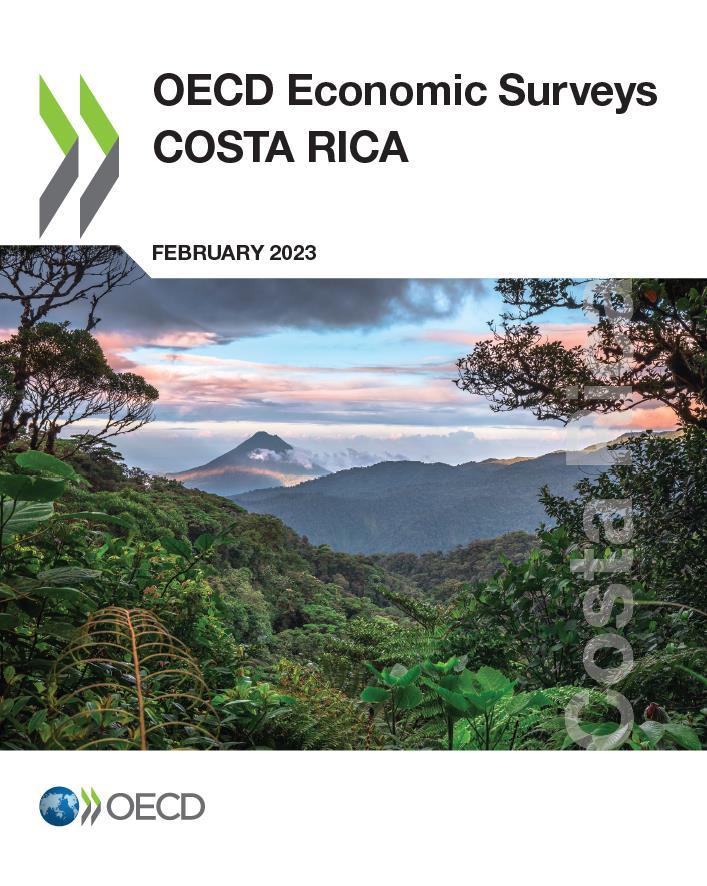OECD ECONOMIC SURVEY OF COSTA RICA



San José, 6 February 2023








San José, 6 February 2023





Note: LAC 6 includes Argentina, Brazil, Chile, Colombia, Costa Rica and Mexico. Source: OECD Economic Outlook 110 database.

Note: LAC includes Chile, Colombia, Mexico, and Brazil.
Source: OECD Economic Outlook database.



Note: Real exports include all goods and services produced by residents abut consumed abroad. They are computed as the ratio of the value of exports of goods an services to the export deflator.
Source: OECD Economic Outlook database.



Note: The ten main exported products in 1994 are displayed in green in both panels. Source: COMEX based on data from PROCOMER.

The goods export basket has become increasingly sophisticated

Note: LAC refers to Chile, Colombia, Mexico, and Brazil. Source: OECD Economic Outlook database.


Note: Inflation expectations are the median one-year ahead expectations according to a survey run by the Central Bank. The survey was not conducted between December 2020 and November 2021.
Source: Banco Central de Costa Rica.









Note: Data refer to central government only. Total revenues do not include social security contributions. The primary balance is defined as the difference between government total revenues less total government spending, excluding net interest payments. A positive value implies that a government is saving, before taking into account net interest payments. The budget balance adds net interest payments to the primary balance and describes the government financial needs.



Note: The chart depicts central government public debt. The “Current government fiscal plans” scenario assumes GDP growth as in table 1.1 until 2023, with a gradual transition to OECD long-term model estimates of potential output thereafter. Inflation is projected as in table 1.1 until 2023 and a gradual convergence to 3% thereafter. Fiscal assumptions are those outlined in table 1.3 and remain constant until 2028 when aging costs, in the form of higher pensions and health costs, will gradually start to kick. The “Ambitious reforms“ scenario assumes the implementation of reforms described in Figure 1.2. Both “Current government fiscal plans” and “Ambitious reforms” scenarios assume full implementation of the fiscal rule. The scenario “Spending growing above the limits established by the fiscal rule” assumes that primary spending is 1% of GDP higher than in current government fiscal plans and that revenues remain as in current government fiscal plans. In the






Note: LAC refers to Chile, Colombia, Mexico, Argentina and Brazil. All averages are unweighted.
Source: OECD Revenue Statistics database.




The tax system is overly reliant on social security contributions


Note: Informality is defined as the percentage of workers in employment meeting one of these conditions
not contributing to the social security system,





Note: OECD average calculated as the simple average across OECD countries with available data.

OECD Productivity database.




Note: The overall PMR indicator measures the regulatory barriers to firm entry and competition in a broad range of key policy areas, ranging from licensing and public procurement, to governance of SOEs, price controls, evaluation of new and existing regulations, and foreign trade. The PMR indicators range from 0 to 6. A lower value represents a more competition friendly regulatory regime


Note: Data for Costa Rica refers to 2019. LAC refers to Chile, Colombia, Mexico, and Brazil. The education budget is distributed to the Ministry of Public Education (Preschool, I and II Cycles, III Cycle and Diversified Education); the Special Fund for Higher Education (5


and the
and about

Percentage of 25-34 year-olds with below upper-secondary education as the highest level attained
Note: LAC refers to Chile, Colombia, Mexico, Argentina, and Brazil.


Source: OECD Education Database.


Note: LAC refers to Chile, Colombia, Mexico, Argentina, Brazil, Panama, Peru, and Uruguay. PISA is the OECD's Programme for International Student Assessment. PISA measures 15-year-olds’ ability to use their reading, mathematics and science knowledge and skills to meet real-life challenges. A higher value indicates that a student has on average a higher ability to use as specific skill (reading, mathematics or science knowledge) to meet real-life challenges.

Source: OECD PISA International Dataset.


Note: The distribution of graduates by field of study is calculated as the share of graduates from each field over the total of graduates. STEM includes all graduates (short-cycle tertiary, bachelor's, master's, and doctoral degrees) with a degree in natural sciences, mathematics and statistics; information and communication technologies; and engineering, manufacturing and construction. LAC refers to Chile, Colombia, Mexico, Argentina, and Brazil.


Working-age (15-64) labour force participation rate
Note: LAC is a simple average of Brazil, Chile, Colombia and Mexico.


Source: OECD Labour Force statistics.



Disclaimers:
The statistical data for Israel are supplied by and under the responsibility of the relevant Israeli authorities The use of such data by the OECD is without prejudice to the status of the Golan Heights, East Jerusalem and Israeli settlements in the West Bank under the terms of international law.

This document and any map included herein are without prejudice to the status of or sovereignty over any territory, to the delimitation of international frontiers and boundaries and to the name of any territory, city or area
